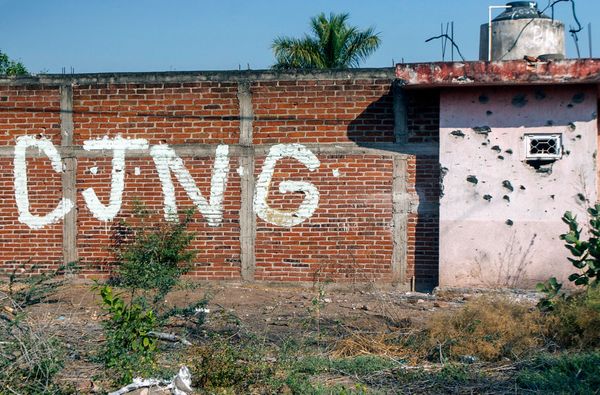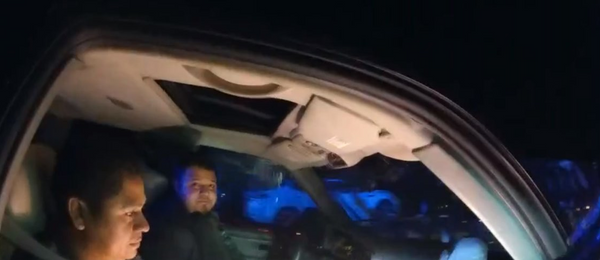
When Pimlico underground station opened in September 1972, it caused a stir in the London art world. The new Victoria line, to which it was a late addition, was intended to showcase British design. Stations would be identified by tiled recesses behind benches along their platforms: artists including Edward Bawden were invited to make these. Pimlico was a particular prize, being the stop for what was then the Tate Gallery, now Tate Britain. The commission for its tiles went to Peter Sedgley, who has died aged 94.
Sedgley seemed an odd choice. In 1972, he was at the height of his engagement with op art. Short for “optical”, a term coined by Time magazine in 1964, the aim of this was to disorient the eye; hardly the ideal pedigree for designing what was, in essence, locational signage. The Pimlico tiles, though, turned out to be reassuringly legible. Each of the 150 squares in Sedgley’s niches bore a yellow disc, smaller and paler towards the middle, darker and larger towards the edge. After half a century, they are still in use.
Sedgley’s role as an op artist was not the only thing that had made his choice for the Tate stop surprising. Four years earlier, he and the performance artist Stuart Brisley had staged what was described in Studio International magazine as an “action-happening” at the gallery.
On the evening of 5 March 1968, the French sculptor César had been invited to entertain Tate members by making a work using quick-drying polyurethane foam. As the sculpture set, Sedgley and Brisley snuck into the Tate, tore chunks off it, raced around to the gallery’s front entrance, impaled the pieces on its railings and set fire to them. They fled before the police arrived.
By 1972, Sedgley was safely out of the country. The previous year, he had visited Berlin as part of the DAAD artist-in-residence programme. The Germans had loved his work: in the year of his arrival, a book called Peter Sedgley: Vibrationen was published. After his stipend ran out, he stayed on. When an exhibition called The Berlin Scene 1972 was held at London’s shortlived Gallery House, Sedgley was included as a German artist. By 1974, the Times newspaper could write that he had more right to the phrase “Ich bin ein Berliner,” than did John F Kennedy.
All this had come about in spite of Sedgley having had no formal training. Born in London to Violet (nee Dickey) and Edward, a railway engineer, he attended the Brixton technical school (1943-47). After two years’ national service with the Royal Army Ordnance Corps in Egypt, he went to work as an architectural assistant in various practices around London. In 1961, he met the painter Bridget Riley, a year younger than he was.
Riley had only just begun working as an op artist, making the first of her monochrome paintings, Kiss, that year. This featured a curved black mass almost, but not quite, touching a black plane below it. Riley acknowledged her debt to Sedgley’s skills in technical drawing.
“I did not know how to make a curve, even how to use a ruler, till I met Peter,” she said. “I was still working on my kitchen table. He had to teach me geometry so that I could make the things I knew ought to be.”
Under Riley’s influence, Sedgley, in turn, began to paint. The two would be involved through the 1960s, working together in a studio in Riley’s Notting Hill house and teaching at the Byam Shaw School of Art.
Sedgley’s paintings of the time were in the round format known as targets, made famous by the American painter Jasper Johns. Sedgley’s Red, Blue & Green Target (1964), in acrylic on wood, dazzled the eye with interwoven circles of colour. Untitled, of the same year, was made with an airbrush, lending its concentric circles a hypnotic fuzziness. The following year, his work and Riley’s would be included in The Responsive Eye, the defining exhibition of op art held at the Museum of Modern Art, New York.
In 1968, the pair also set up Space (Space Provision Artistic Cultural and Educational) at St Katharine Docks in London, based on schemes they had seen in New York in 1965. Taking cheap leases on the area’s by now empty warehouses, they turned these into affordable loft studios for fellow artists. Space is now the oldest such organisation in London, having added international residency and exhibition programmes to its role.
In 1971, Sedgley curated a show called London Now in Berlin, bringing the work of Space artists to his new home.
Shortly before leaving London, he had introduced electric light to his work in a series called Colour Cycles. Colour Cycle III (1970), in the Tate collection, is typical of these, its concentric circles of colour seeming to pulse and glow as the light from a series of dichroic lamps falls on them in a 12-minute programmed sequence.
In Berlin, Sedgley took these experiments further. The introduction of light had also added movement to his art. Now, he worked as a kinetic artist, making mobile sculptures such as the solar-powered Colorama (1997) and Spinette (2004) that refracted light into the spaces in which they hung.
In 1969, in London, Sedgley had been one of the founding members of the Systems Group, which sought to remove the element of authorial choice from its members’ work. Fortuna (1994), a steel-and-glass mobile named for the goddess of chance, showed this provenance by gyrating randomly.
In the half century that he lived in Berlin, Sedgley was admired as a living artist. In 1997, a one-man retrospective at the Museum of Fine Art in Prague filled the entire building with his work, including Fortuna. In Britain, he appeared largely in historical exhibitions, as an artist from another time. His recent work was occasionally shown in private galleries, but it was the art he had made in London, as a pioneer op artist, that commanded most interest. In 2016, his painting Light Pulse No 3 (1968) was included in Electronic Superhighway (2016-1966) at the Whitechapel Gallery. In his 90s, he returned to Britain and settled in Worthing, Sussex.
In 1951, Sedgley married Marguerite Wiltshire. They had two children, Richard and Laura, and later divorced. In Berlin, Sedgley met the photojournalist Ingeborg Lommatzsch. They married in 1996, and she died in 2022. Richard died in 1979; Sedgley is survived by Laura, and a granddaughter, Kathleen.
• Peter Sedgley, artist, born 19 March 1930; died 16 March 2025







